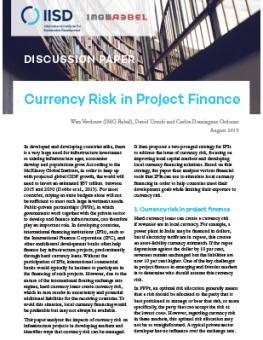
Currency Risk in Project Finance
In developing countries, international financing institutions (IFIs) often help finance key infrastructure projects, predominantly through hard currency loans.
In developing countries, international financing institutions (IFIs) often help finance key infrastructure projects, predominantly through hard currency loans.
Without the participation of IFIs, international commercial banks would typically be hesitant to participate in the financing of such projects. However, due to the nature of the international floating exchange rate regime, hard currency loans create currency risk, which in turn results in uncertainty and potential additional liabilities for the receiving countries. To avoid this situation, local currency financing would be preferable but may not always be available.
This paper analyzes the impacts of currency risk on infrastructure projects in developing markets and identifies ways that currency risk can be managed. It then proposes a two-pronged strategy for IFIs to address the issue of currency risk, focusing on improving local capital markets and developing local currency financing solutions. Based on this strategy, the paper then analyzes various financial tools that IFIs can use to stimulate local currency financing in order to help countries meet their development goals while limiting their exposure to currency risk.
This paper was funded by the Danish International Development Agency (DANIDA).
Participating experts
You might also be interested in
Monitoring Progress in Green Public Procurement
This report outlines the importance of monitoring progress in green public procurement (GPP) and highlights various methodologies, challenges, and recommendations.
Gender Equality at the Heart of Recovery: Advocating for Gender-Responsive Procurement in Ukraine
Ukraine is already preparing for reconstruction, which will cost an estimated USD 411 billion and take at least 10 years. The integration of gender considerations into public procurement processes could generate greater inclusivity in a rebuilt Ukraine.
A Sustainable Asset Valuation of Non-Motorized Transport in Coimbatore, India
A Sustainable Asset Valuation (SAVi) of the economic, social, and environmental benefits of a non-motorized transport (NMT) network in Coimbatore, India.
FAQ: Legal Considerations When Using the CO2 Performance Ladder in Public Procurement
This report answers frequently asked questions about the legal aspects of using the CO2 Performance Ladder as a green public procurement tool.